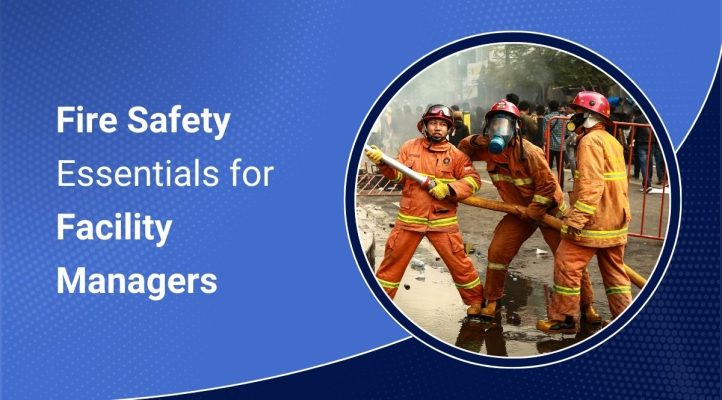Have You Adopted These Critical Fire Safety Measures?

Ensuring fire safety in a facility is a fundamental responsibility of every facility manager. Fires can cause significant property damage, disrupt operations, and endanger lives. Facility managers can minimize risks and enhance overall preparedness by implementing proactive measures and maintaining emergency response systems. This guide outlines essential practices that every facility should adopt.
Fire Risk Assessment
A thorough fire risk assessment is the foundation of an effective fire safety plan. This involves:
- Identifying fire hazards such as flammable materials, faulty wiring, and heat sources.
- Evaluating risks to employees, visitors, and property.
- Implementing preventive measures to reduce risks.
- Regularly reviewing and updating assessments.
Fire Prevention Strategies
Prevention is the first line of defense against fire incidents. Facility managers should:
- Establish strict housekeeping protocols to eliminate fire hazards.
- Ensure electrical systems are up to code and undergo routine inspections.
- Store flammable substances properly and minimize their quantity on-site.
- Implement no-smoking policies in designated areas.
Emergency Systems and Equipment
The right emergency systems are critical to responding effectively to fire emergencies. Key components include:
- Fire Alarm Systems: Regular testing and maintenance of alarms ensure prompt fire detection.
- Sprinkler Systems: Automatic sprinkler systems help control fires before they spread.
- Fire Extinguishers: Strategically placing fire extinguishers and training staff on their use is essential.
- Emergency Lighting: Properly maintained emergency lighting guides occupants to safety during evacuations.
- Fire Doors and Escape Routes: Unobstructed exit paths and functional fire doors slow fire spread and enable safe evacuations.
Fire Safety Training for Staff
Educating staff on fire safety protocols enhances preparedness and response efficiency. Training should include:
- Recognizing fire hazards and reporting them promptly.
- Proper use of fire extinguishers and other fire suppression tools.
- Familiarization with evacuation procedures and designated assembly points.
- Conducting fire drills to reinforce emergency response plans.
Regular Fire Drills and Evacuation Planning
Fire drills help identify potential weaknesses in emergency plans. Facility managers should:
- Schedule routine fire drills to test evacuation routes.
- Assign fire wardens responsible for guiding occupants during emergencies.
- Evaluate and improve evacuation procedures based on drill performance.
- Communicate evacuation plans to all occupants and ensure accessibility for people with disabilities.
Compliance with Fire Safety Regulations
Facility managers must stay up to date with local fire codes and regulations, which may include:
- Adhering to building codes for fire-resistant materials and designs.
- Meeting OSHA and NFPA (National Fire Protection Association) requirements.
- Keeping records of fire inspections, maintenance, and compliance reports.
- Working with local fire departments for site evaluations and recommendations.
Implementing a Fire Safety Culture
Creating a safety-conscious workplace fosters proactive fire risk management. Encouraging employee involvement and maintaining open communication about fire safety can help build a resilient facility. Facility managers should:
- Promote a culture of accountability for fire safety.
- Recognize and reward proactive fire safety efforts.
- Provide continuous education on evolving fire safety best practices.
Rhythm Innovations: Enhancing Fire Safety Solutions
Rhythm Innovations offers cutting-edge solutions to help facility managers improve fire safety measures and streamline emergency preparedness. Our technology-driven approach integrates fire risk assessment tools, real-time monitoring, and compliance tracking to ensure facilities meet the highest safety standards. With intuitive dashboards and automated reporting, Rhythm Innovations empowers facility managers to mitigate fire hazards proactively.
By leveraging our advanced fire safety management solutions, organizations can enhance their emergency response capabilities, optimize maintenance schedules for fire protection systems, and ensure continuous compliance with regulatory requirements. Whether you need a comprehensive fire safety plan or tools to monitor emergency systems efficiently, Rhythm Innovations provides the expertise and technology to safeguard your facility and its occupants.
Conclusion
Fire safety is a critical responsibility for facility managers, requiring a proactive approach to risk assessment, prevention, emergency preparedness, and compliance. By implementing these fire safety essentials, facility managers can protect lives, reduce property damage, and ensure business continuity. Regular training, proper emergency systems, and an intense fire safety culture make all the difference in mitigating fire risks effectively.
For more insights on facility risk management solutions, contact Rhythm Innovations today.




